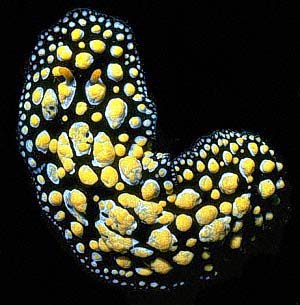
Phyllidia tula
Marcus & Marcus, 1970
Order: NUDIBRANCHIA
Suborder: DORIDINA
Family: Phyllidiidae
DISTRIBUTION
Known only from Micronesia.
PHOTO
14 m depth, Bile Bay, Guam, 29 June 1988, dorsal view of 52 mm specimen. PHOTO: D.Brunckhorst. (Brunckhorst, 1993: Plate 1E).
Notes compiled from Brunckhorst, 1993:
The distinctive features of P. tula include: its numerous, yellow, rounded tubercles which are isolated or coalesced only at their base and do not form ridges (as occur in Phyllidia varicosa and Phyllidia coelestis ); a gradation in tubercle size from the central area to the marginal edge of the mantle; a dark grey ventral surface, except for the black stripe on the foot sole and the yellow tips of the oral tentacles; and oral tentacles which are triangular in shape with pointed ends rather than rounded as occur in P. varicosa and P. coelestis.
Reference:
• Brunckhorst, D.J. (1993) The systematics and phylogeny of Phyllidiid Nudibranchs (Doridoidea). Records of the Australian Museum, Supplement 16: 1-107.
Rudman, W.B., 1999 (January 12) Phyllidia tula Marcus & Marcus, 1970. [In] Sea Slug Forum. Australian Museum, Sydney. Available from http://www.seaslugforum.net/find/phyltula
Related messages
Phyllidia tula ? from Bali
October 31, 2008
From: Marcel Tanke
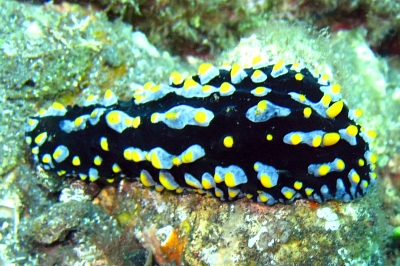
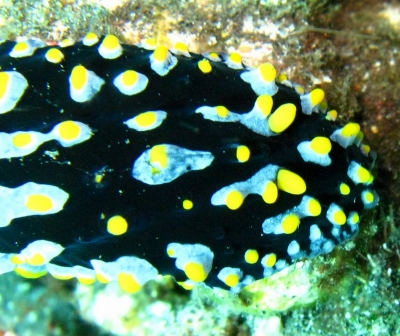
Concerning message #2001:
Dear Bill,
Could these be Phyllidia tula, or P. madangensis? Picture 1 and 2 are from the same animal. Picture 3 shows an animal with a damaged mantle.
Locality: Tulamben, Bali, 10 m, Indonesia, 30 September 2008, Black sand. Length: 6 cm. Photographer: Marcel Tanke.
Best regards,
Marcel
marceltanke@cs.com
Tanke, M.A., 2008 (Oct 31) Phyllidia tula ? from Bali. [Message in] Sea Slug Forum. Australian Museum, Sydney. Available from http://www.seaslugforum.net/find/21995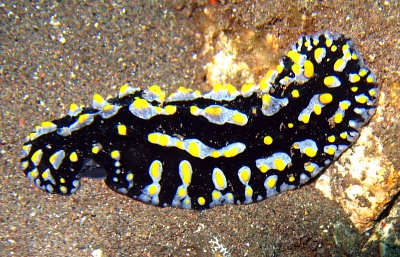
Dear Marcel,
Yes I think this is P. tula. In P. madangensis, and the similar P. carlsonhoffi, the tubercles are distinctly separate, while in your animal groups of tubercles are linked by a basal bluish patch, sometimes almost a low ridge.
Best wishes,
Bill Rudman
Phyllidia tula from French Polynesia
December 23, 2000
From: Daniel L. Geiger
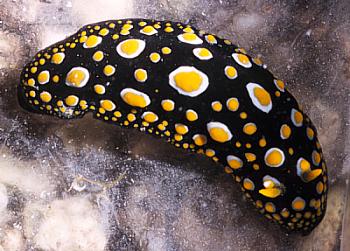
Dear Bill
Here is a Phyllidia sp. (multiple specimens available) from Rangiroa, frencj Polynesia, which I collected in August 2000. Again, specimens are availble for molecular work.
Daniel
dgeiger@nhm.org
Thanks Daniel,
I am pretty sure that this is Phyllidia tula which previously has only been recorded from Micronesia. Although see Clay Bryce's photo from the Marquesas Ids.
There are two other similarly coloured species, Phyllidia madangensis and Phyllidia carlsonhoffi but in both those species the tubercles are essentially white with a yellow tip and they don't have the large numbers of small tubercles scattered around the mantle edge.
An interesting find.
Bill Rudman.
Phyllidia tula? from the Marquesas Ids
March 7, 2000
From: Clay Bryce
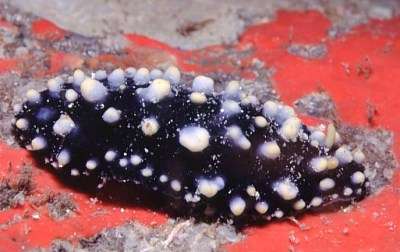
Hi Bill,
Here is a phyllidiid I recently collected in the Marquesas Islands.
It matches Brunckhorst's description of Phyllidia tula except that the colouring is a little on the pale side. The foot has a stripe and the oral tube has the 2 longitudinal stripes on the dorsal surface.
Data: Nuku Hiva, Marquesas Is., 25m on rocky slope, 19/10/99
All the best,
Clay Bryce
brycec@museum.wa.gov.au
Dear Clay,
On first view I wouldn't have suggested P. tula. It looks most like Phyllidia madangensis but that species does not have a median dark line on the sole and no markings on the foregut. The next most similar is Phyllidia carlsonhoffi which does have a median line on the sole but has a dark transverse band on the foregut.
Which leaves P. tula. Although 'typical' Phyllidia tula is more tuberculate than the Marquesas' animal, it matches in having both a median dark line on the sole and two dark longitudinal lines on the foregut.
Cheers,
Bill Rudman.
